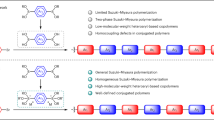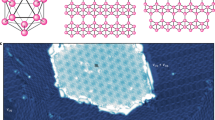Abstract
Herein, borafluorene-conjugated polymers with a dibromoborafluorene monomer and various boronic acid ester comonomers are reported. By employing the Suzuki−Miyaura cross-coupling reaction, a series of copolymers was prepared with the boron atoms in tetracoordinated states. Based on comparison to the optical properties of gallafluorene copolymers, higher luminescence quantum yields were obtained from the synthesized borafluorene copolymers due to the weak spin-orbit interaction of boron compared to that of gallium. Additionally, the results from the electrochemical measurements indicated that the electron-withdrawing property of the boron atoms led to stabilization of the lowest unoccupied molecular orbitals (LUMOs) of the borafluorene copolymers. In the X-ray diffraction profiles, significant peaks originating from π−π stacking and assembly of the side chains were observed. The borafluorene copolymers were more crystalline than the gallafluorene polymers.
Similar content being viewed by others
Log in or create a free account to read this content
Gain free access to this article, as well as selected content from this journal and more on nature.com
or
References
Chujo Y, Tanaka K. New polymeric materials based on element-blocks. Bull Chem Soc Jpn 2015;88:633–43.
Gon, M, Tanaka, K, Chujo, Y. Recent progress in the development of advanced element-block materials. Polym J. https://doi.org/10.1038/pj.2017.56
Tamada M, Iino T, Wang Y, Ide M, Saeki A, Furuta H et al. Facile synthesis of dimeric Aza-BODIPY analogues from electron-deficient bislactams and their intriguing optical and electrochemical properties. Tetrahedron Lett 2017;58:3151–4.
Shiina Y, Karasaki H, Mori S, Kobayashi N, Furuta H, Shimizu S. A novel isoindole-containing polyaromatic hydrocarbon unexpectedly formed during the synthesis of meso-2,6-dichlorophenyl-substituted tribenzosubporphyrin. J Porphyrins Phthalocyanines 2016;55:1049–54.
Ooyama Y, Hato M, Enoki T, Aoyama S, Furue K, Tsunoji N et al. BODIPY sensor for water based on photo-induced electron transfer method with fluorescence enhancement and attenuation systems. New J Chem 2016;40:7278–81.
Miki K, Enomoto A, Inoue T, Nabeshima T, Saino S, Shimizu S et al. Polymeric self-assemblies with boron-containing near-infrared dye dimers for photoacoustic imaging probes. Biomacromolecules2017;18:249–56.
Saikawa M, Nakamura T, Uchida J, Yamamura M, Nabeshima T. Synthesis of figure-of-eight helical bisBODIPY macrocycles and their chiroptical properties. Chem Commun 2016;52:10727–30.
Okada D, Nakamura T, Braam D, Dao TD, Ishii S, Nagao T et al. Color-tunable resonant photoluminescence and cavity-mediated multistep energy transfer cascade. ACS Nano 2016;10:7058–63.
Suenaga, K, Tanaka, K, Chujo, Y. Design and luminescent chromism of fused boron complexes having constant emission efficiencies in solution, amorphous and crystalline states. Eur J Org Chem. 2017;2017: https://doi.org/10.1002/ejoc.201700704.
Ohtani, S, Gon, M, Tanaka, K, Chujo, Y. Flexible fused azomethine–boron complex: thermally-induced switching of crystalline-state luminescent property and thermosalient behaviors based on phase transition between polymorphs. Chem Eur J. 2017;25: https://doi.org/10.1002/chem.201702309.
Yamane H, Ohtani S, Tanaka K, Chujo Y. Synthesis of furan-substituted aza-bodipys having strong near-infrared emission. Tetrahedron Lett 2017;58:2989–92.
Yamaguchi M, Ito S, Hirose A, Tanaka K, Chujo Y. Control of aggregation-induced emission versus fluorescence aggregation-caused quenching by the bond existence at the single site in boron pyridinoiminate complexes. Mater Chem Front 2017;1:1573–9.
Suenaga K, Tanaka K, Chujo Y. Heat-resistant mechanoluminescent chromism of the hybrid molecule based on boron ketoiminate-modified octa-substituted polyhedral oligomeric silsesquioxane. Chem Eur J 2017;23:1409–14.
Yamaguchi M, Ito S, Hirose A, Tanaka K, Chujo Y. Modulation of sensitivity to mechanical stimulus in mechanofluorochromic properties by altering substituent positions in solid-state emissive diiodo boron diiminates. J Mater Chem C 2016;3:5314–19.
Yeo H, Tanaka K, Chujo Y. Tunable optical property between pure red luminescence and dual-emission depended on the length of light-harvesting antennae in the dyads containing the cardo structure of BODIPY and oligofluorene. Macromolecules 2016;49:8899–904.
Yamane H, Ito S, Tanaka K, Chujo Y. Preservation of main-chain conjugation through BODIPY-containing alternating polymers from electronic interactions with side-chain substituents by cardo boron structures. Polym Chem 2016;7:2799–807.
Suenaga K, Yoshii R, Tanaka K, Chujo Y. Sponge-type emissive chemosensors for the protein detection based on boron ketoiminate-modifying hydrogels with aggregation-induced blue shift emission property. Macromol Chem Phys 2016;217:414–7.
Braunschweig H, Kupfer T, Direct functionalization at the boron center of antiaromatic chloroborole. Chem Commun 2008;0:4487–9
Yuan Z, Taylor NJ, Ramachandran R, Marder TB. Third-order nonlinear optical properties of organoboron compounds: molecular structures and second hyperpolarizabilities. Appl Organomet Chem. 1996;10:305–16.
Wakamiya, A, Mishima, K, Ekawa, K, Yamaguchi, S. Kinetically stabilized dibenzoborole as an electron-accepting building unit. Chem Commun. 2008:579–81.
Araki T, Fukazawa A, Yamaguchi S. Electron-donating tetrathienyl-substituted borole. Angew Chemie Int Ed 2012;51:5484–7.
Sun Y, Ross N, Zhao S-B, Huszarik K, Jia W-L, Wang R-Y et al. Enhancing electron accepting ability of triarylboron via π-conjugation with 2,2’-bipy and metal chelation: 5,5’-Bis(BMes2)-2,2’-bipy and its metal complexes. J Am Chem Soc 2007;129:7510–1.
Bonifácio VDB, Morgado J, Scherf U. Polyfluorenes with on-chain dibenzoborole units−synthesis and anion-induced photoluminescence quenching. J Polym Sci Part A Polym Chem 2008;46:2878–83.
Matsumi N, Naka K, Chujo Y. Extension of π-conjugation length via the vacant p-orbital of the boron atom. synthesis of novel electron deficient π-conjugated systems by hydroboration polymerization and their blue light emission. J Am Chem Soc 1998;120:5112–3.
Yamaguchi S, Shirasaka T, Akiyama S, Tamao K. Dibenzoborole-containing π-electron systems: remarkable fluorescence change based on the ‘on/off’ control of the pπ−π* conjugation. J Am Chem Soc 2002;124:8816–7.
Yin, X, Liu, K, Ren, Y, Lalancette, RA, Loo, Y-L, Jäkle, F. Pyridalthiadiazole acceptor-functionalized triarylboranes with multi-responsive optoelectronic characteristics. Chem Sci. 2017; 8:5497–505.
Pawar GM, Sheridan JB, Jäkle F. Pyridylborates as a new type of robust scorpionate ligand: from metal complexes to polymeric materials. Eur J Inorg Chem 2016;2016:2227–35.
Ren Y, Jäkle F. Merging thiophene with boron: new building blocks for conjugated materials. Dalton Trans 2016;45:13996–14007.
Tanaka K, Chujo Y. Advanced luminescent materials based on organoboron polymers. Macromol Rapid Commun 2012;33:1235–55.
Entwistle CD, Marder TB. Applications of three-coordinate organoboron compounds and polymers in optoelectronics. Chem Mater 2004;16:4574–85.
Hudson ZM, Wang S. Impact of donor−acceptor geometry and metal chelation on photophysical properties and applications of triarylboranes. Acc Chem Res 2009;42:1584–96.
Ito S, Hirose A, Yamaguchi M, Tanaka K, Chujo Y. Size-discrimination for volatile organic compounds utilizing gallium diiminate by luminescent chromism of crystallization-induced emission via encapsulation-triggered crystal-crystal transition. J Mater Chem C 2016;3:5564–71.
Ito S, Hirose A, Yamaguchi M, Tanaka K, Chujo Y. Synthesis of aggregation-induced emission-active conjugated polymers composed of group 13 diiminate complexes with tunable energy levels via alteration of central element. Polymers2017;9:68–78.
Matsumoto T, Tanaka K, Chujo Y. Synthesis and optical properties of stable gallafluorene derivatives: investigation of their emission via triplet states. J Am Chem Soc 2013;135:4211–4.
Matsumoto T, Onishi Y, Tanaka K, Fueno H, Tanaka K, Chujo Y. Synthesis of conjugated polymers containing gallium atoms and evaluation of conjugation though four-coordinate gallium atoms. Chem Commun 2014;50:15740–43.
Matsumoto T, Takamine H, Tanaka K, Chujo Y. Synthesis of air- and moisture-stable dibenzogallepins: control of planarity of seven-membered rings in solid states by coordination to gallium atoms. Org Lett 2015;17:1593–96.
Matsumoto T, Tanaka K, Chujo Y. High HOMO levels and narrow energy band gaps of dithienogalloles. RSC Adv 2015;5:55406–10.
Matsumoto T, Takamine H, Tanaka K, Chujo Y. Synthesis and characterization of heterofluorenes with five-coordinated group 13 elements. Chem Lett 2015;44:1658–60.
Chen R-F, Zheng C, Fan Q-L, Huang W. Structural, electronic, and optical properties of 9-heterofluorenes: a quantum chemical study. J Comput Chem 2007;28:2091–101.
Blouin N, Leclerc M. Poly(2,7-carbazole)s: structure−property relationships. Acc Chem Res 2008;41:1110–9.
Allard N, Aïch RB, Gendron D, Boudreault P-LT, Tessier C, Alem S et al. Germafluorenes: new heterocycles for plastic electronics. Macromolecules 2010;43:2328–33.
Tanaka S, Imoto H, Yumura T, Naka K. Arsenic halogenation of 9-arsafluorene and utilization for As−C bond formation reaction. Organometallics 2017;36:1684–87.
Matsumura Y, Ishidoshiro M, Irie Y, Imoto H, Naka K, Tanaka K et al. Arsole-containing π-conjugated polymer by post-element-transformation-technique. Angew Chem Int Ed 2016;55:15040–3.
Matsumoto T, Tanaka K, Tanaka K, Chujo Y. Synthesis and characterization of heterofluorenes containing four-coordinated group 13 elements: theoretical and experimental analyses and comparison of structures, optical properties and electronic states. Dalton Trans 2015;44:8697–707.
Tokoro Y, Nagai A, Chujo Y. Synthesis of highly luminescent organoboron polymers connected by bifunctional 8-aminoquinolate linkers. J Polym Sci Part A Polym Chem 2010;48:3693–701.
Matsumoto, T, Takamine, H, Tanaka, K, Chujo, Y. Design of bond-cleavage-induced intramolecular charge transfer emission with dibenzoboroles and their application to ratiometric sensors for discriminating chain lengths of alkanes. Mater Chem Front 2017;1:2368–75.
Matsumoto T, Tanaka K, Chujo Y. Synthesis and characterization of gallafluorene-containing conjugated polymers: Control of emission colors and electronic effects of gallafluorene units on π-conjugation system. Macromolecules 2015;48:1343–51.
Yeo H, Tanaka K, Chujo Y. Isolation of π-conjugated system through polyfluorene from electronic coupling with side-chain substituents by cardo structures. J Polym Sci Part A Polym Chem 2012;50:4433–42.
Gibson GL, McCormick TM, Seferos DS. Effect of group-14 and group-16 substitution on the photophysics of structurally related donor–acceptor polymers. J Phys Chem C 2013;117:16606–15.
Gibson GL, Seferos DS. “Heavy-atom” donor–acceptor conjugated polymers. Macromol Chem Phys 2014;215:811–23.
Acknowledgments
This work was partially supported by the Noguchi Institute (for K.T.) and a Grant-in-Aid for Scientific Research on Innovative Areas “New Polymeric Materials Based on Element-Blocks (No.2401)” (JSPS KAKENHI Grant Number JP24102013).
Author information
Authors and Affiliations
Corresponding authors
Ethics declarations
Conflict of interest
The authors declare that they have no competing interests.
Electronic supplementary material
Rights and permissions
About this article
Cite this article
Matsumoto, T., Ito, S., Tanaka, K. et al. Synthesis, properties and structure of borafluorene-based conjugated polymers with kinetically and thermodynamically stabilized tetracoordinated boron atoms. Polym J 50, 197–202 (2018). https://doi.org/10.1038/s41428-017-0002-x
Received:
Revised:
Accepted:
Published:
Issue date:
DOI: https://doi.org/10.1038/s41428-017-0002-x



